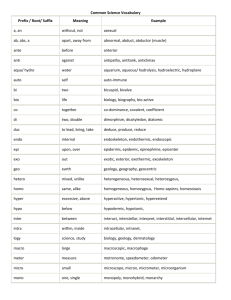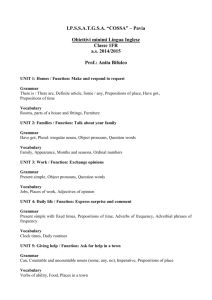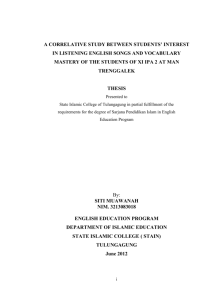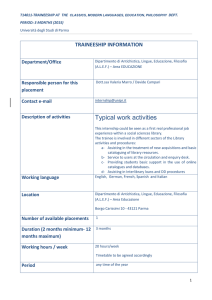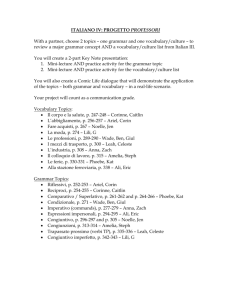Document
advertisement
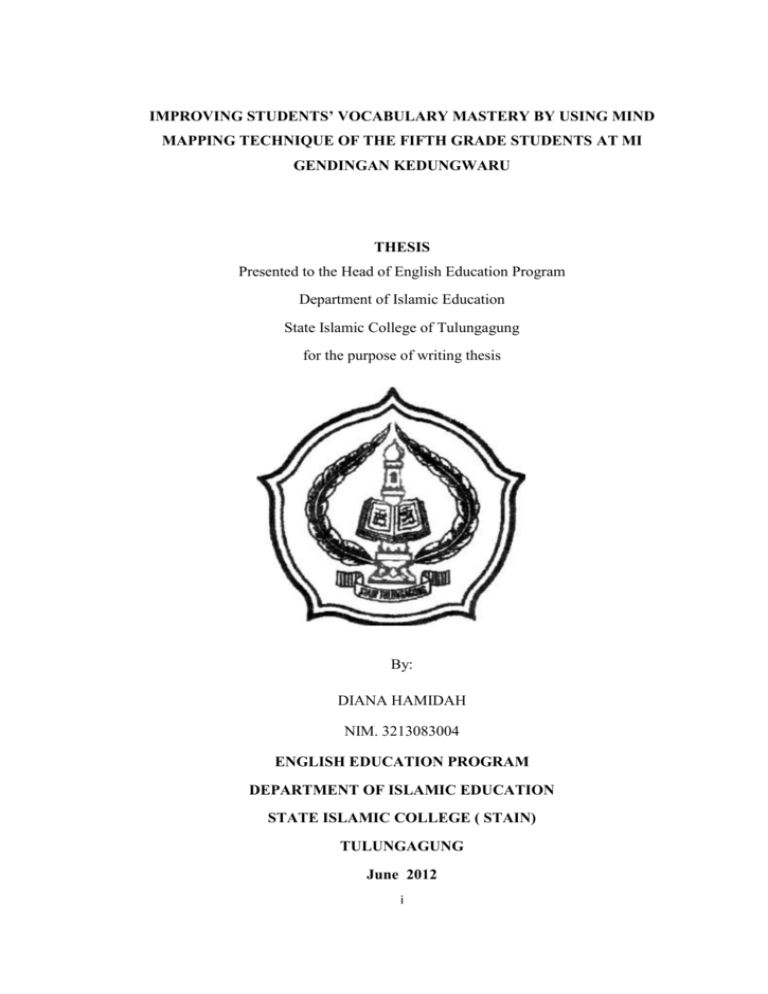
IMPROVING STUDENTS’ VOCABULARY MASTERY BY USING MIND MAPPING TECHNIQUE OF THE FIFTH GRADE STUDENTS AT MI GENDINGAN KEDUNGWARU THESIS Presented to the Head of English Education Program Department of Islamic Education State Islamic College of Tulungagung for the purpose of writing thesis By: DIANA HAMIDAH NIM. 3213083004 ENGLISH EDUCATION PROGRAM DEPARTMENT OF ISLAMIC EDUCATION STATE ISLAMIC COLLEGE ( STAIN) TULUNGAGUNG June 2012 i IMPROVING STUDENTS’ VOCABULARY MASTERY BY USING MIND MAPPING TECHNIQUE OF THE FIFTH GRADE STUDENTS AT MI GENDINGAN KEDUNGWARU THESIS Presented to State Islamic College of Tulungagung in partial fulfillment of the requirements for the degrre of Sarjana Pendidikan Islam in English Education Program By DIANA HAMIDAH NIM. 3213083004 ENGLISH EDUCATION PROGRAM DEPARTMENT OF ISLAMIC EDUCATION THE STATE COLLEGE FOR ISLAMIC STUDIES (STAIN) TULUNGAGUNG 2012 ii ADVISOR’S APPOVAL SHEET This is to certify that the Sarjana’s thesis of Diana Hamidah has been approved by the thesis advisors for further approval by the Board of Examiners. Tulungagung, Mei 23th 2012 Advisor Nurul Chojimah M.Pd. iii LEGITIMATION FROM THE BOARD OF THESIS EXAMINERS This is certify that the Sarjana’s thesis of Diana Hamidah has been approved by the Board of Examiners as the requirement for the degree of Sarjana Pendidikan Islam in English Education Program Board of Thesis Examiners Chair Secretary Muhammad Basuni M.Pd. Nurul Chojimah. M.Pd. NIP. 197803122003121001 NIP. 196906292009012001 Main Examiner Dr. Hj. Dwi Ima H. Hum NIP. 196206201989032002 Tulungagung, 14 June 2012 Approved by The Chief of STAIN Tulungagung Dr. Maftukhin, M.Ag. NIP. 196707172000031002 iv MOTTO IF YOU DON’T STAND FOR SOMETHING, YOU WILL FALL FOR ANYTHING v DEDICATIONS I dedicate this thesis to : My beloved parents who always pray for me, give love and patient, and always support me. “Thanks for your support and everything that you gave to me. I love you, really-really love you mom” All of my family, my brother’s who always support me. All of my friends Of TBI-A who have helped me to finish this thesis. “Thanks for your support and motivation” vi ABSTRAK Hamidah , Diana. Nim 3213083004, 2012. Peningkatan penguasaan kosakata dengan menggunakan Mind Map teknik pada siswa kelas lima di MI AL MA’ARIF Gendingan Kedungwaru. Skripsi, Pendidikan Bahasa Inggris, STAIN Tulungagung. Pembimbing : Nurul Chojimah M.Pd. Kata Kunci : Kosakata, Teknik Mind map. Belajar kosa-kata merupakan bagian yang terpenting untuk mempelajari sebuah bahasa. Penguasaan kosa-kata merupakan bagian yang mendasar untuk belajar lebih tentang bahasa inggris, karena kosa-kata berperan penting dalam mengajar bahasa inggris. Sebuah alasan untuk hal ini yaitu, semakin banyak kosa-kata yang kamu ketahui, kamu akan lebih mudah untuk memahami apa yang kamu dengar dan apa yang kamu baca. Selain itu kamu akan lenih mudah untuk mengatakan apa yang kamu inginkan pada saat berbicara maupun menulis. Di tingkat SD, siswa menghadapi beberapa masalah dalam belajar kosakata, hal ini terlihat setelah peneliti mengadakan wawancara dengan guru bahasa inggis di sekolah tersebut. Pertama, sulit bagi mereka untuk menjawab pertanyaan yang ada dalam materi. Kedua, mereka juga masih sedikit kesulitan untuk melafalkan kata dengan benar. Dan yang ke tiga, mereka masih kesulitan untuk memahami makna dan isi suatu bacaan pendek, karena kosa-kata yang mereka kuasai masih sedikit. Oleh karena itu, guru harus dapat memilih dan menerapkan teknik yang sesuai untuk mengajar. Penelitian ini dilakukan dengan masalah berikut: "Bagaimana penerapan teknik peta pikiran dapat meningkatkan pemahaman kosa-kata siswa kelas lima di sekolah MI Gendingan pada tahun akademik 2011/2012" Tujuan dari penelitian ini adalah untuk meningkatkan penguasaan kosa-kata siswa. Siswa kelas lima MI Gendingan pada tahun akademik 2011/2012 dengan menggunakan teknik pemetaan pikiran. Dalam penelitian ini menggunakan Penelitian Tindakan Kelas (PTK). Itu disesuaikan dari model Kemmis dan Mc Taggart. Penelitian dilakukan dalam dua siklus, setiap siklus meliputi perencanaan, pelaksanaan, pengamatan dan refleksi. Subjek pada penelitian ini adalah siswa kelas lima di MI Gendingan yang terdiri dari 30 siswa. Penelitian ini dilaksanakan dari tanggal 6 April 2012 sampai dengan tanggal 4 Mei 2012. Instrumen yang digunakan untuk memperoleh data, adalah wawancara dengan guru bahasa Inggris, lembar observasi, field note dan tes untuk menganalisis data. Data analisis dari wawancara, lembar observasi dan field note digunakan untuk mengetahui sikap siswa dan kondisi kelas sebelum dan saat penerapan teknik mind map. Data nilai siswa diperoleh dari tes kosa-kata. Test kosa-kata dilakukan untuk menganalisis kemampuan siswa dalam pengusaan vii kosa-kata yang diambil dari test yang diberikan kepada siswa. Nilai tersebut digunakan untuk menilai siswa dalam penguasaan kosa-kata. Berdasarkan hasil dari tes, ada sebuah peningkatan yang signifikan pada hasil siswa dan sesuai dengan kriteria of sukses.Teknik ini dikatakan sukses jika memenuhi syarat dari kriteria sukses yang mencakup dua aspek yaitu, hasil dari test tersebut harus terdapat 80% siswa yang mendapat nilai bagus atau lebih dari standart yang diberikan yaitu 65. Nilai dari siswa pada siklus 2 meningkat dibandingkan dengan nilai para siswa dalam penelitian awal dan siklus 1. Pada penelitian awal, ada 12 (40%) siswa yang lulus tes, pada siklus 1 ada 19 (63%) siswa yang lulus tes, dan pada siklus 2 ada 26 (87%) siswa yang lulus tes. Faktor utama yang mempengaruhi peningkatan ini karena siswa benar-benar berminat dalam belajar menguasai kosa-kata melalui teknik mind map. Mereka lebih aktif dan memberikan respon positif selama proses belajar mengajar berlangsung. Hal ini dapat dilihat pada hasil test siwa. Ada 26 (87%) siswa yang tertarik dan mendapat nilai yang bagus. Hasil dari penelitian ini menunjukkan bahwa teknik mind map dapat meningkatkan pemahaman siswa dalam penguasaan kosa-kata. Disamping itu, perkembangan dari pemahaman siswa dalam kosa-kata dapat ditunjukkan dari perbandingan hasil penelitian pada penelitian awal, siklus 1 dan siklus 2. Sehingga, dapat disimpulkan bahwa teknik mind map dapat digunakan untuk meningkatkan pengusaan kosa-kata untuk siswa kelas lima di MI Gendingan tahun pelajaran 2011/2012. Kemudian, disarankan bagi guru bahasa Inggris untuk menerapkan teknik mind map sebagai sebuah alternatif teknik pada pengajaran kosa-kata. Untuk siswa, teknik mind map dapat membantu mereka untuk lebih mudah dalam menguasai kosa-kata. Selain itu bagi peneliti-peneliti lain, disarankan menggunakan hasil dari penelitian ini sebagai sebuah masukan untuk mengadakan sebuah penelitian selanjutnya yang berhubungan dengan teknik yang sama, tetapi dengan bentuk penelitian yang berbeda dan subyek penelitian yang berbeda. viii ABSTRACT Hamidah, Diana. Registered Student. 3213083004. 2012, Improving Students’ Vocabulary Mastery by Using Mind Mapping Technique of Fifth Grade Students at MI Gendingan Kedungwaru. Thesis. English Education Program. State Islamic College (STAIN) of Tulungagung. Advisor (I) Nurul Chojimah, M.Pd. Key words: Students’ Vocabulary, Mind Map Technique. Lerning vocabulary is a very important part of learning a language. Vocabulary mastery is the very basic knowledge to learn more about English, because vocabulary is the important role in English language Teaching . There is a reason for this, the more words you know, the more you will be able to understand what you hear and read, and the better you will be able to say what you want to when speaking or writting. In Elementary School level, students face some problems in vocabulary. It was found after the researcher’s interview with English teacher at the school. First, the students difficult to answer the questions. Second, the students difficult to pronounce words correctly and the third, they have difficulty to understand about the meaning and content of a short text because the students’ vocabulary mastery is still low. Therefore, the teacher should be able to choose and implement a suitable technique to teach. This research was conducted with the following problem: “How can the implementation of mind map technique improve students’ vocabulary mastery of the fifth year students of MI Gendingan in the academic year 2011/2012?” The objective of this research is to improve students’ vocabulary mastery of fifth year student of MI Gendingan by using mind map technique. This study used Classroom Action Research (CAR). It is adapted from Kemmis and Mc. Taggart’s model. The research was conducted in two cycles, each cycle covers planning, acting, observing and reflecting. The subject of the research were the fifth year students at MI Gendingan that consists of 30 students. This research was held from April, 6th 2012, to May, 4th 2012. The instrument used to collect the data is interview, observation sheet, field notes and tests to analysis the data. The data of interview, observation sheet and field notes were used to find out the students’ attitude and the condition of the classroom before and after mind map technique implemented . The result of the study before and after implemented mind map technique was different, before the implemented mind map the students’ vocabulary still low, but after mind map was implemented the students’ vocabulary more improved. The data on the students’ score were obtained from the vocabulary tests. The vocabulary test was used to know the ix students’ score. The scores were used to evaluate the students’ vocabulary mastery. The result of the test shows improvement of the students’ score was included of criteria of success. The criteria of success was covered two aspects, there are 80% students who get good score equal (> 65) in vocabulary test. The scores of the students in cycle 2 increased compared to the scores of the students in preliminary study and cycle 1. On preliminary study, there were 12 (40%) students who passed the test, in cycle 1 there were 19 (63%) students who passed the test, and in cycle 2 there were 26 (87%) students who passed the test. The main factor that affects this improvement was the students’ interest in learning vocabulary mastery through mind mapping technique. They were more active and gave positive responses in teaching and learning process. It could be seen by the result of students’ score of the test. There were 26 (87%) students were interested and get the good score. The results of the research showed that mind mapping technique could improve the students’ vocabulary mastery. Beside that, the development of the students’ vocabulary mastery could be shown from the comparison of the result of the preliminary study, cycle 1 and cycle 2. So, it can be concluded that mind mapping technique is able to be used to improve the fifth year students’ vocabulary at MI Gendingan in the academic year 2011/2012. Then, it is suggested for the English teacher to apply mind mapping technique as an alternative technique in teaching vocabulary. For the students, mind map technique can be used to help them to master the vocabulary. Moreover, for the other researcher, it is suggested to use the result of the research as an input to conduct a further research dealing with the same technique but with different research design and different subject. x ACKNOWLEDGEMENTS Alhamdulillahirobbil’alamin, it is the first sentence I am able to say to express my happiness and gratitude since I eventually could accomplish this thesis. I release that without Allah SWT, I could not finish my thesis. What the writer has written in this thesis is far from being perfect. So, the writer expects comments and suggestions to make it better. This thesis will never finish without helping, guiding, and advising from other side. Therefore, the writer would like to express her gratitude and appreciation to: 1. Dr. Maftukhin, M.Ag., the Chief of STAIN Tulungagung for his permission to write this thesis. 2. Arina shofiya, M.Pd., the Head of English Education Program who has given me some information so the writer can accomplish this thesis. 3. Nurul Chojimah, M.Pd., the writer’s thesis advisor, for her invaluable guidance, suggestion, and feedback during the completion of this thesis. 4. Drs. Kamim Tohari, the headmaster of MI AL MA’ARIF Gendingan who has given the writer permission to cundect a research at this school. This research is far from being perfect. Therefore, any constructive critism and suggestion will be gladly accepted. Tulungagung, 14 June 2012 The Writer xi TABLE OF CONTENTS Page Cover ........................................................................................................ i Advisors’ Sheet ........................................................................................ ii Examiners’ Sheet ..................................................................................... iii Motto ........................................................................................................ iv Dedications ............................................................................................... v Abstract .................................................................................................... vi Acknowledgments .................................................................................... x Table of Contents ..................................................................................... xii List of Tables ............................................................................................ xv List of Figures ........................................................................................... xvi List of Appendices ................................................................................... xvii CHAPTER I INTRODUCTION 1.1 Background of The study ........................................................... 1 1.2 Statement of The Problem ......................................................... 5 1.3 Purpose of the Study ................................................................... 5 1.4 Scope and Limitation ................................................................. 5 1.5 Significance of the Study ........................................................... 6 1.6 Definition of Key Terms ............................................................ 7 CHAPTER II REVIEW TO THE RELATED LITERATURE 2.1 Theaching English in Elementary School .................................. 8 2.1.1 The Definition of Young Learner ...................................... 10 2.1.2 The Characteristic of Young Learner ................................ 15 2.2 Teaching Vocabulary ................................................................. 18 2.2.1 Definition of Vocabulary ................................................... 20 2.2.2 Kinds of Vocabulary .......................................................... 22 2.2.3 Types of Vocabulary .......................................................... 23 2.2.4 Vocabulary Development .................................................. 23 2.3 The History of Mind Map .......................................................... 25 2.3.1 The Concept of Mind Map Technique .............................. 26 2.3.2 Definition of Mind Map Technique .................................. 28 2.3.3 Parts of Mind Map Technique ........................................... 29 xii 2.3.4 The Criteria of Making Mind Map Technique ................. 31 2.3.5 The Theoritical Procedures of Teaching Vocabulary Through Mind Map .......................................................... 32 2.3.6 The Advantages of Using Mind Map Technique ............... 33 2.4 Assessment in Vocabulary ......................................................... 35 2.4.1 Multiple Choice ................................................................ 36 2.4.2 Completion ........................................................................ 36 2.4.3 Matching .......................................................................... 36 CHAPTER III RESEARCH METHOD 3.1 Research Design ........................................................................ 38 3.2 Setting and Subject of The Study ............................................... 40 3.2.1 Setting ............................................................................... 40 3.2.2 Subject of The Study ......................................................... 40 3.3 Data and Source of Data ............................................................ 41 3.4 Data Collection Method ............................................................. 41 3.5 Research Instruments ................................................................. 42 3.5.1 Vocabulary Test ................................................................ 42 3.5.2 Observation Sheet ............................................................. 42 3.5.3 Documentation .................................................................. 42 3.6 Research Procedure .................................................................... 42 3.2.1 Preliminary Study ............................................................. 44 3.2.2 Planning ............................................................................ 44 3.2.3 Acting ................................................................................ 46 3.2.4 Observing .......................................................................... 48 3.2.5 Reflecting .......................................................................... 48 3.7 Data Analysis ............................................................................. 48 3.7.1 Data Analysis of Test ........................................................ 49 3.7.2 Data Analysis of Observations .......................................... 49 CHAPTER IV RESEARCH FINDINGS AND DISCUSSION 4.1 The Research Findings .............................................................. 50 4.1.1 Data from preliminary Study ............................................ 50 4.1.2 Action Research of Cycle 1 .............................................. 52 4.1.3 Action Research of Cycle 2 .............................................. 57 4.2 Research Discussions ................................................................. 61 xiii CHAPTER V CONCLUSION AND SUGGESTION 5.1 Conclusions ............................................................................... 64 5.2 Suggestions ................................................................................ 65 BIBLIOGRAPHY .................................................................................... 66 APPENDICES ......................................................................................... 68 xiv LIST OF TABLES Page Table 4.1 The students achievement in preliminary study ........................ 51 Table 4.2 The students’ vocabulary score of cycle 1 ................................ 55 Table 4.3 The students’ vocabulary score of cycle 2 ................................ 59 Table 4.4 The percentage of students’ success in vocabulary test in preliminary, cycle 1 and cycle 2 .................................... 62 xv LIST OF FIGURES Page Figure 2.1 Parts of Our Brain ................................................................... 27 Figure 2.2 The Example of Mind Map ..................................................... 31 Figure 3.1 The Procedure of Classroom Action Research ..................... 43 xvi LIST OF APPENDICES Appendix 1 Time Schedule Appendix 2 Teachers’ Interview Guide in Preliminary Study Appendix 3 Preliminary Test Appendix 4 Lesson Plan Cycle 1 Meeting 1 and 2 Appendix 5 Test Cycle 1 Appendix 6 The Teacher Observation Sheet Cycle 1 Meeting 1 Appendix 7 Field Note Cycle 1 Meeting 1 Appendix 8 The Teacher Observation Sheet Cycle 1 Meeting 2 Appendix 9 Field Note Cycle 1 Meeting 2 Appendix 10 Lesson Plan Cycle 2 Meeting 1 and 2 Appendix 11 Test Cycle 2 Appendix 12 The Teacher Observation Sheet Cycle 2 Meeting 1 Appendix 13 Field Note Cycle 2 Meeting 1 Appendix 14 The Teacher Observation Sheet Cycle 2 Meeting 2 Appendix 15 Field Note Cycle 2 Meeting 2 Appendix 16 Documentation Car Appendix 17 Student’s Attendance xvii
